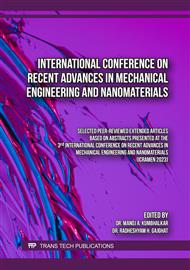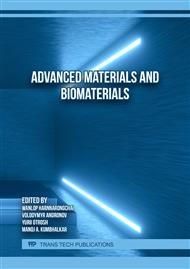[1]
Z.Yinping, J.Yi, J.Yi, A simple method, the T–history method, of determining the heat of fusion, specific heat, and thermal conductivity of phase-change materials, Meas.Sci. Technol. 10 (1999) 201–205.
DOI: 10.1088/0957-0233/10/3/015
Google Scholar
[2]
J.M. Marın, B.Zalba, L.F. Cabeza, H.Mehling, Determination of enthalpy–temperature curves of phase change materials with the temperature-history method: improvement to temperature-dependent properties, Meas.Sci.Technol.14(2003)184–189.
DOI: 10.1088/0957-0233/14/2/305
Google Scholar
[3]
H. Honga, S.K. Kim, Y. Kim, Accuracy improvement of T-history method for measur-ing the heat of fusion of various materials, Int.J.Refrig.27(2004)360–366.
Google Scholar
[4]
J.H. Peck, J.Kimb, C.Kang, H.Hong, A study of accurate latent heat measurement for a PCM with a low melting temperature using T-history method, Int. J. Refrig. 29(2006)1225–1232.
DOI: 10.1016/j.ijrefrig.2005.12.014
Google Scholar
[5]
A.Lazaro, E.Gunther, H.Mehling, S.Hiebler, J.M. Marın, B.Zalba, Verification of a T-history installation to measure enthalpy versus temperature curves of phase change materials, Meas.Sci.Technol.17 (2006)2168–2174.
DOI: 10.1088/0957-0233/17/8/016
Google Scholar
[6]
I.M. Sutjahja, A.O. Silalahi, N.Sukmawati, D.kurnia, S.Wonorahardjo, Variation of thermo physical parameters of PCMC a Cl2.6H2O with dopant from T-history data analysis, Mater. Res.Exp.5 (2018), 034007.
DOI: 10.1088/2053-1591/aab6f0
Google Scholar
[7]
P.Tana, M.Brütting, S.Vidi, H.Ebert, P.Johansson, A.S. Kalagasidis, Characterizing phase change materials using the T-history method: on the factors influencing the accuracy and precision of the enthalpy-temperature curve, Thermo chimica Acta666(2018)212–228.
DOI: 10.1016/j.tca.2018.07.004
Google Scholar
[8]
Z. Huang, N. Xie, Z. Luo, X. Gao, X. Fang, Y. Fang, Z. Zhang, Characterization of medium-temperature phase change materials for solar thermal energy storageusing temperature history method, Sol. Energy Mater.Sol. Cells 179(2018)152–160.
DOI: 10.1016/j.solmat.2017.11.006
Google Scholar
[9]
F.Agyenim, P.Eames, M.Smyth, A comparison of heat transfer enhancement in a medium-temperature thermal energy storage heat exchanger using fins, Solar En-ergy 83(2009) (2009) 1509–1520.
DOI: 10.1016/j.solener.2009.04.007
Google Scholar
[10]
J.Gasia, J.Diriken, M.Bourke, J.V. Bael, L.Cabeza, Comparative study of the thermal performance of four different shell-and-tube heat exchangers used as latent heat thermal energy storage systems, Renew.Energy114 (2017)934–944.
DOI: 10.1016/j.renene.2017.07.114
Google Scholar
[11]
N.H.S. Tay, M. Liu, M. Belusk, F. Bruno, Review on transportable phase change mate-rial in thermal energy storage systems, Renew. Sustain. Energy Rev. 75 (2017)264–277.
DOI: 10.1016/j.rser.2016.10.069
Google Scholar
[12]
S.Harikrishnan, S.I. Hussain, A.Devaraju, P.Sivasamy, S.Kalaiselvam, Improved per-formance of a newly prepared nano-enhanced phase change material for solar en-ergy storage, J.Mech. Sci.Techno l.31 (2017)4903–4910. S.C. Lin, H.H. Al-Kayiem, Evaluation of copper nanoparticles – paraffin wax compo-sitions for solar thermal energy storage, Sol. Energy 132 (2016) 267–278.
DOI: 10.1007/s12206-017-0938-y
Google Scholar
[13]
A.Ebrahimi, A.Dadvand, Simulation of melting of a nano-enchanted phase change material in a squa recavity with two heat source-sink pairs, Alex. Eng.J.54 (2015)1003–1017.
DOI: 10.1016/j.aej.2015.09.007
Google Scholar
[14]
R.Sharma, P.Ganesan, V.Tyagi, H.Metselaar, S.Sandaran, Thermal properties, and heat storage analysis of palmiticacid-TiO2 composite as a nano-enhanced organic phase change material, Appl. Therm. Eng.99 (2016)1254–1262.
DOI: 10.1016/j.applthermaleng.2016.01.130
Google Scholar
[15]
Y.Addad, M.Abutayeh, E.Abu-Nada, Effects of nano fluids on the performance of a PCM-based thermal energy storage system, J.Energy Eng.143 (2017)1–7.
DOI: 10.1061/(asce)ey.1943-7897.0000433
Google Scholar
[16]
N. Sahan, H.O. Paksoy, Thermal enhancement of paraffin as a phase change material with nano magnetite, Sol. Energy Mater. Sol. Cells 126(2014)56–61.
DOI: 10.1016/j.solmat.2014.03.018
Google Scholar
[17]
R.M. Seaeed, J.P. Schlegel, C. Castano, R. Sawafta, Preparation and enhanced thermal performance of novel (solid to gel) form-stable eutectic PCM modified by nano-graphene platelets, J. Energy Storage15 (2018)91–102.
DOI: 10.1016/j.est.2017.11.003
Google Scholar
[18]
J.L. Zeng, Z. Cao, D.W. Yang, F. Xu, L.X. Sun, X.F. Zhang, L. Zhang, Effects of MWNTs on phase change enthalpy and thermal conductivity of a solid-liquid organic PCM, J.Therm. Anal. Calorim. 95(2009)507–512.
DOI: 10.1007/s10973-008-9275-9
Google Scholar
[19]
M.P. Deqiu, S. Kurtulus, U.N. Temel, K. Yapici, Thermal property investigation of Multi-Walled Carbon Nanotubes (MWCNTs) embedded Phase Change Materials(PCMs),15th IEEEI THERM Conference, 2016 ,978-1-4673-8121-5.
DOI: 10.1109/itherm.2016.7517608
Google Scholar
[20]
D. Zou, X. Ma, X. Liu, P. Zheng, Y. Hu, Thermal performance enhancement of com-posite phase change materials (PCM) using graphene and carbon nano tubes as ad-ditives for the potential application in lithium-ion power battery, Int.J. Heat MassTransf. 120(2018)33–41.
DOI: 10.1016/j.ijheatmasstransfer.2017.12.024
Google Scholar
[21]
C. Yadav, R.R. Sahoo, Exergy, and energy comparison of organic phase change mate-rials based thermal energy storage system integrated with engine exhaust, J. Energy Storage 24 (2019), 100773.
DOI: 10.1016/j.est.2019.100773
Google Scholar
[22]
C. Yadav, R.R. Sahoo, Effect of thermal performance on melting and solidification of lauric acid PCM in cylindrical thermal energy storage, J.Phys. Conf. Ser.1240 (2019),012088.
DOI: 10.1088/1742-6596/1240/1/012088
Google Scholar
[23]
Patrick Nicholas, A review of phase change materials for vehicle component thermal buffering, Appl. Energy 113 (2014)1525–1561.
DOI: 10.1016/j.apenergy.2013.08.026
Google Scholar
[24]
S. Shaikh, K. Lafdi, K. Hallinan, Carbon nano additives to enhance latent energy stor-age of phase change materials, J. Appl. Phys.103 (2008)094302–094306.
DOI: 10.1063/1.2903538
Google Scholar
[25]
J.P. Holman, W.J. Gajda, Experimental Methods for Engineers, Mc Graw-Hill, New York, 2001.
Google Scholar
[26]
N. Totala, M. Shimpi, N. Shete, V. Bhopate, Natural convection characteristics in a vertical cylinder, Int.J.Eng.Sci.3(2013)27–31.
Google Scholar



